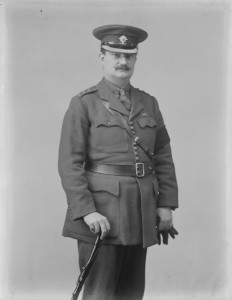‘The renewal of a pledge of faith’? ‘John Redmond Days’ in the south-east in the 1920s
Published in 20th-century / Contemporary History, Features, Issue 1 (January/February 2015), Volume 23The centenaries of the third Home Rule bill and the outbreak of the First World War have sparked debate on how Irish Parliamentary Party leader John Redmond was allegedly wiped from the historical memory of independent Ireland. In fact, the early 1920s saw major national tributes paid to Redmond, with thousands of old supporters in attendance.
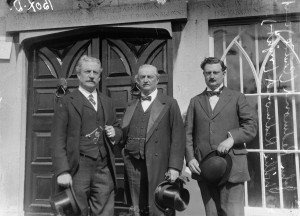
Above: John Redmond (centre) in 1912, with his brother Willie (left) and son, Capt. W.A. Redmond (right). Memorial events to John Redmond began the year after his passing. (NLI)
Given his family’s years of service, it is perhaps unsurprising that John Redmond’s anniversary would be marked in his heartland of Waterford and Wexford. What is perhaps more interesting is that for a few short years such commemorations reached far beyond local gatherings. Dermot Meleady is correct that ‘fears of hostile demonstration’ denied the Irish Parliamentary Party (IPP) leader a public funeral in Dublin in March 1918. Redmond had passed away a deeply unpopular political leader and was instead laid to rest in the family vault in his home town of Wexford.
Memorial events to John Redmond began, however, the year after his passing, when a tribute was paid at St John’s Cemetery, Wexford. Just months after the IPP’s electoral defeat to Sinn Féin, this was a well-attended affair, with supporters from various parts of the country present. IPP MP Joseph Devlin delivered an oration in which he argued that if it had not been for the extraordinary events leading into the Great War Redmond would by 1919 have been leading a unified self-governing Ireland from College Green. Devlin was setting the scene for future commemorations where the IPP was staunchly defended, often with Redmondite evaluations of past events and the invocation of the dead leader’s memory as that of a heroic figure.
Although the War of Independence and Civil War saw the Redmond anniversary become a muted and local affair, in 1924 and 1925 the anniversaries became national tributes and major social occasions where practices of collective memory and ideas of political organisation could sometimes overlap. It would become clear that fidelity to Redmond and his party had not disappeared.
The 1924 anniversary
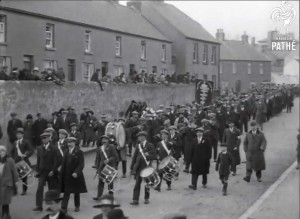
One of the c. 30 bands that marched at the John Redmond anniversary event in Wexford on 9 March 1924. The Irish Times recorded a crowd of 20,000 and added that the demonstration ‘seemed to warrant the assumption that one was watching the renewal of a pledge of faith in the political beliefs and methods discarded by the electorate only a few years before’. (British Pathé)
However great an event the Waterford anniversary, held on the first Sunday in March, was for the Redmondites in that city, the event the following week in Wexford was the official one and, as peace returned to the country, 1924 was developed into a national event.
In November 1923, at the first meeting of the Dublin committee set up to organise the following year’s John Redmond anniversary, the chair was taken by the IPP’s last leader, John Dillon. The committee contained numerous ex-IPP MPs and other figures associated with the old party. This committee liaised with the chief organising committee in Wexford and committees around the country to plan and prepare for the event to be held on 9 March 1924.
While the IPP may have been no more, the scale of the event showed the breadth of support—or at least admiration—for the Redmonds. The Irish Independent described it as a ‘remarkable revelation of the depth of affection’ that still existed for Redmond. The Irish Times recorded a crowd of 20,000 and added that the demonstration ‘seemed to warrant the assumption that one was watching the renewal of a pledge of faith in the political beliefs and methods discarded by the electorate only a few years before’. Local politicians from Wexford and Waterford were present and, in addition to those ex-IPP members in the Dublin anniversary committee, other ex-MPs and current TDs with IPP backgrounds attended. Such was the success of the John Redmond events in 1924 that committees from Dublin and Louth called for the 1925 memorial to be held in the capital. The decision of the Wexford committee to keep the event in the south-east was, however, accepted by followers all over the Free State. Although this may have perhaps hinted at a continued regional bias in affairs, the 1925 event, at which Devlin again spoke, was almost as big as the previous year, before the regression towards a more local gathering in 1926.
Who took part?
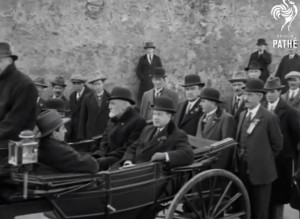
Former IPP leaders—facing forward in the carriage—John Dillon (left) and Joe Devlin (right) at the 1924 event. Dillon gave the oration in 1924 and Devlin in 1925. (British Pathé)
Assessment of the attendance at the Redmond anniversaries reveals members of the groupings once associated with the IPP which had persisted into the 1920s, such as the Ancient Order of Hibernians and Irish National Foresters, as well as branches of the Legion of Ex-Servicemen, of which Redmond’s son, Captain William, was a prominent member. In Waterford local groups loyal to Redmond may be added to the list, like the Women’s Nationalist Association and the Ballybricken Pig-Buyers’ Association (devoted followers of the Redmond family from the 1880s), and in Wexford the Mechanics’ Institute and the YMCA.
The proliferation of bands was another feature, with over 30 attending the events in 1924 and 1925. Bands of the various Legion branches had clear lines of Redmondite loyalty, as did the Waterford-based Barrack Street Band and Willie Redmond’s Own Brass and Reed Band from Ennis. Many followers travelled by specially arranged trains. In 1924 the Dublin anniversary committee organised trains from Harcourt Street to Wexford. Arrangements were also made for excursion trains from the midlands, Limerick and Tipperary. The journey from Belfast was the most arduous, with a train leaving the city at 7.15am. In fact, the vast attendance in both years also included parties from Cavan, Louth, Clare and Cork joining the local contingents. The Wexford committee coordinated with local hotels and restaurants to cater for the crowds coming from around the country. These Redmondite events allowed those of similar opinions to offer strident defences of the party and its record while paying their respects to a man whom they held in the highest esteem as a patriot.
Symbolism and ritual
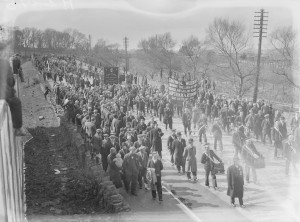
‘Faithful Waterford mourns the loss of their beloved and gallant member, Captain W.A. Redmond. God rest his soul’—the funeral of John Redmond’s son in 1932. The large crowd belied the fact that by then Redmondite commemorations had lost momentum. (NLI)
Taking their lead from the 1919 event, the anniversary events typically began with Masses celebrated for the repose of the soul of John Redmond in the churches of Wexford, with a procession in the afternoon. In 1924 this began in Wexford at the Redmond monument and wound its way through numerous streets before returning for John Dillon’s oration. Afterwards, the contingent could then visit the former leader’s grave in St John’s Cemetery. The Last Post was played by buglers at the site before wreaths and flowers were laid at the tomb.
In 1925, after Devlin gave the oration at the Redmond monument, the bands played the Dead March in Saul before the sounding of the Last Post, when all heads were uncovered. Heads were once again uncovered as they passed by the cemetery, at which bands would stop playing until they reached Rowe Street. Another part of the ritual and symbolism for the Wexford occasion was the wearing of the violet, John Redmond’s favourite flower, recommended by the Wexford organising committee. This constituted the donning of a mark of respect for the former party leader, just as those attending Parnell events tended to wear ivy. In Waterford violet rosettes were available from the local Hibernian Hall, and in Dublin there were Redmond violets for sale on 6 March 1924, the actual anniversary of his death. Local groups also carried banners in the processions, such as ‘Faithful Waterford mourns Ireland’s dead leader’, while others carried a huge oil painting of Redmond. In 1925 there were also two flags, ‘one emblazoned with the sunburst and the other with the harp’.
Political significance?
For some who attended the Redmond anniversaries it had been enough to resuscitate the memory of the man and the party. Looking ahead to the 1924 event, J.P. Gaynor stated that ‘they were not there for a political purpose, but to perform an act of national duty . . . and in some sense a penance for the wrong that their country had inflicted upon him’. Yet there was an apparent contradiction between paying tribute to Redmond and not being there for a political purpose.
Dillon’s 1924 oration appeared to occupy the same territory. Dillon claimed that the people now realised the mistake they had made in disposing of Redmond and referenced how ‘even Parnell’ failed to win self-government. Dillon criticised the Treaty, the slow progress of the Boundary Commission and the performance of the new government, which, he complained, excluded ‘a large section of the Nation’s representatives from the National Parliament’. Dillon even declared that ‘so far as I can see his [Redmond’s] Imperialism was faint compared with the Imperialism of the men who are at present in control’.
The speech by Captain William Redmond was less openly critical of the government, though he disputed the claim that his father had ‘failed’, arguing that he could only be said to have failed if failure meant ‘failure to betray his country, selling a portion of it for a name, or accepting a truncated Ireland’. While the success of the 1924 event seemed to surprise many old IPP followers, by 1925 the comments of the Times about a resurgence of ‘old nationalism’ were beginning to look less mischievous.
Captain Redmond took the lead in telling the crowds in Wexford that, were his father able to speak to them, he would tell them to ‘carry on and close up the ranks’. Redmond also appeared to go further than simple allusion to his Dáil seat when he claimed it a part of his inheritance to participate in the government of his country. In 1924 Dillon had defended a historical party and, despite occasional rumours, had no intention of future political activity. Redmond’s speech, however, was a statement of ambitious portent, furnished with a call to the old constitutionalists present to join him. Behind the scenes, Redmond, fellow ex-MP Tom O’Donnell and other old members were planning to form a new political party. Such moves can be traced through Redmond anniversaries, and at an anniversary for Willie Redmond at Ennis in June 1926 Captain Redmond declared the work of his uncle ‘yet to be completed’ and called on the crowd to ‘come with me and we will fight as we fought before’.
Redmondite commemorations lost momentum after the decision to have a local commemoration in Wexford in 1926, but many of the old nationalists in each area who formed committees for Redmond anniversaries instead worked to organise the new National League party. Indeed, the League launched itself with two major rallies, including processions of many of the same individuals and groups, in Waterford and Wexford in September and October 1926.
Conclusion
The Redmond anniversaries highlighted the persistence of an ‘old nationalist’ constituency of opinion not just in the south-east but also in the wider Free State. It was not the only nationalist anniversary held at the time. Unlike the Wolfe Tone or the Griffith–Collins commemorations, however, the Redmond anniversaries were paying tribute to a nationalist tradition seemingly denigrated just a few short years earlier. The closest comparison might be the Parnell commemorations organised by William Field, but by the 1920s that was a diminishing event with just hundreds in attendance. The organisation, ritual and rhetoric of the Redmond anniversaries seemed to reinforce the sense of followers of the old party wishing to restore its memory in the new state. It provided a form of vernacular memory for such people to remember John Redmond. It would be for others, like Captain Redmond and O’Donnell, to look at the crowds and see ‘inspiration in the great nationalist movements of the past’.
The John Redmond events lost national prominence after 1926. The emergence and collapse of the National League damaged their potential, as ‘Redmondism’ was resurrected only to be defeated again by 1927. Nonetheless, these events had a collective significance for those old IPP members sidelined in the early 1920s and were the chief reminders of the older political tradition in the vastly changed landscape of the early 1920s.
Martin O’Donoghue is an IRC postgraduate scholar at NUI Galway.
Read More: Willie Redmond events
Redmond family
Further reading
J.A. Gaughan, A political odyssey: Thomas O’Donnell, MP for West Kerry, 1900–1918 (Dublin, 1983).
D. Meleady, John Redmond: the national leader (Dublin, 2014).










